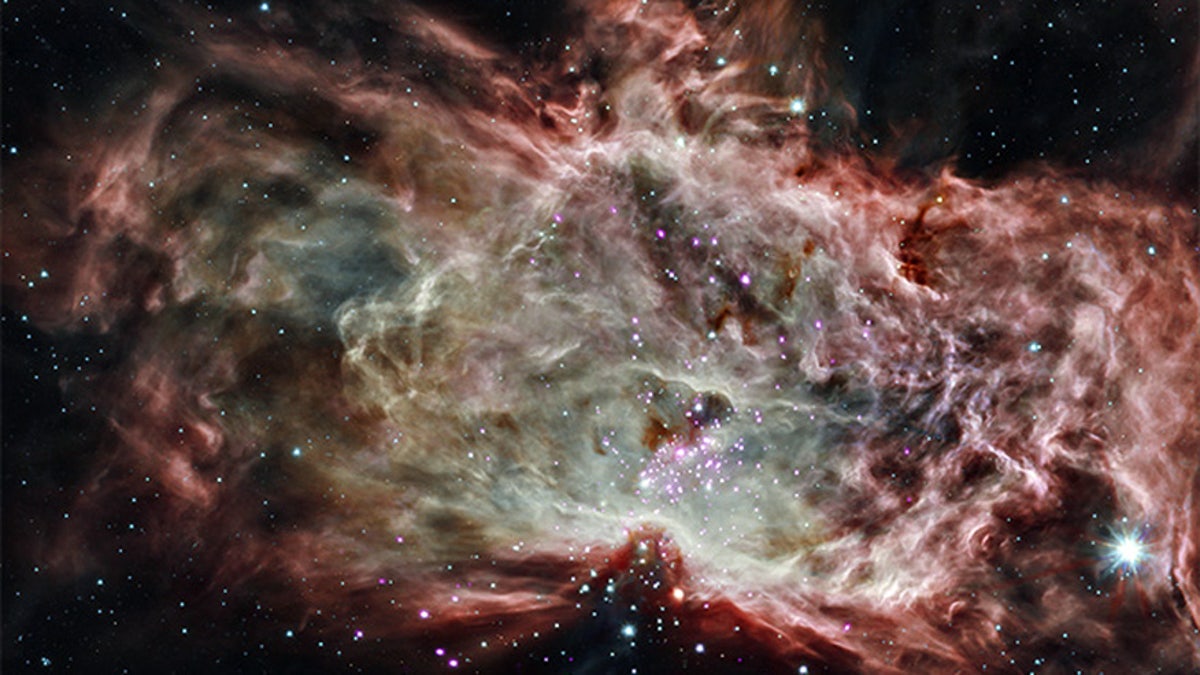
NGC 2024 is a star cluster found in the center of the Flame Nebula, approximately 1,400 light-years from Earth. This observation combines X-ray and infrared data from NASA's Chandra and Spitzer space telescopes, respectively. (NASA)
We thought we had star formation mechanisms pinned down, but according to new observations of two star clusters, it seems our understanding of how stars are born is less than stellar.
PHOTOS: Herschel’s Coolest Infrared Hotshots
When zooming in on the young star clusters of NGC 2024 (in the center of the Flame Nebula) and the Orion Nebula Cluster, NASA’s Chandra X-ray Observatory teamed up with infrared telescopes to take a census of star ages. Conventional thinking suggests that stars closest to the center of a given star cluster should be the oldest and the youngest stars can be found around the edges.
However, to their surprise, astronomers have discovered that the opposite is true.
“Our findings are counterintuitive,” said Konstantin Getman of Penn State University, lead scientist of this new study. “It means we need to think harder and come up with more ideas of how stars like our sun are formed.”
It is thought that stars form after the gravitational collapse of vast clouds of dust and gas, or nebulae. The densest material can be found at the nebula’s center and, as the thinking goes, will be ripe for the first stars in that nebula to appear. After the first stars in the nebula’s center burst to life with fusion burning cores, the leftover gases in the less dense portions of the nebula will generate stars later on.
ANALYSIS: Orion’s ‘Death Stars’ Exterminate Baby Planets
After using Chandra data to gauge the stars’ masses and brightnesses, and then combining that data with infrared observations, stellar ages could be calculated. In the case of NGC 2024, the researchers noticed that the stars in the cluster’s core were 200,000 years old, but the stars on the outer edges were much older — around 1.5 million years old. Likewise, the Orion Nebula Cluster hosts stars in its core that are 1.2 million years old and the ones around the edge were 2 million years old.
This discovery has caught astrophysicists on the hop and may turn our understanding of star forming regions on its head.
“A key conclusion from our study is we can reject the basic model where clusters form from the inside out,” said coauthor Eric Feigelson, also of Penn State. “So we need to consider more complex models that are now emerging from star formation studies.”
So what’s going on? Is our understanding of stellar mechanics really that wrong? Not necessarily, but star cluster evolution models will certainly need some tweaking.
NEWS: Spitzer Sheds Light on Colony of Baby Stars
The researchers have several possible answers to the conundrum. First, it could be that there’s simply more gas in the center of the star-forming nebula that allows stars to be born long after stars have finished forming in the depleted edges of the cluster. That would make it appear that there are older stars at the edges than in the core. Secondly, stars that formed first in the cluster’s center have more time to gravitationally interact with other stars, causing them to be slingshotted to the cluster’s edges, leaving younger stars behind.
Thirdly, the young stars could be formed in the cluster’s center by filaments of gas and dust that fall into the center of the cluster. This could be envisaged as a sort of “conveyer belt” effect where older stars are replaced in the core by new stars being created by in-falling material.
Whether one of these theories is the correct one (or whether it’s a combination of all three) remains to be seen, but this is certainly a reminder that the physics of star formation is far from being fully understood; it is an exciting and evolving field of study that turns up its fair share of surprises.
